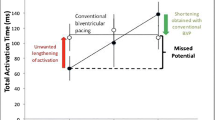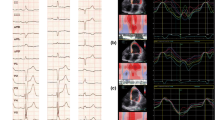Abstract
Background
Intrinsic atrioventricular (AV) conduction is used to optimize AV intervals with cardiac resynchronization therapy (CRT) in most device algorithms. Atrial pacing and heart rate affect conduction times, but little is known regarding differeces among chronotropic incompetent(CI) and competent(CC) patients to guide programming.
Methods
RAVE was a multicenter prospective trial of CRT patients. Heart rate was increased with incremental atrial pacing and with submaximal exercise. According to the maximal heart rate achieved during exercise, patients were classified as either CI or CC. For CI patients, an additional symptom-limited exercise with rate-adaptive pacing activated was performed. Intracardiac intervals were measured from the implantable lead electrograms in multiple postures.
Results
There were 12 subjects with CI and 24 with CC. With atrial pacing, AV interval immediately increased and gradually increased with incremental atrial pacing in all patients. However, the changes in the atrial to right ventricular (ARV) and atrial to left ventricular (ALV) intervals with increasing atrial pacing rates were about threefold greater in CI patients compared to CC patients (24.3 ± 28.9 vs. 7.2 ± 5.5 ms/10 bpm for ARV and 22.7 ± 25.6 vs. 7.1 ± 5.7 ms/10 bpm for ALV in the standing position, p < 0.05). In CI pacing with rate-adaptive pacing during exercise, AV interval changes with paced heart rate were variable.
Conclusions
The AV response to overdrive atrial pacing at rest may provide a simple means of identifying chronotropic competence in CRT patients. For patients with CI, who often require rate-adaptive atrial pacing, rate-adaptive AV algorithms should be adjusted individually.




Similar content being viewed by others
Data Availability
The data that support the findings of this study are not openly available due to reasons of sensitivity and are available from the corresponding author upon reasonable request.
References
Bui AL, Horwich TB, Fonarow GC. Epidemiology and risk profile of heart failure. Nat Rev Cardiol. 2011;8:30–41. https://doi.org/10.1038/nrcardio.2010.165.
Jorde UP, Vittorio TJ, Kasper ME, Arezzi E, Colombo PC, Goldsmith RL, Ahuja K, Tseng CH, Haas F, Hirsh DS. Chronotropic incompetence, beta-blockers, and functional capacity in advanced congestive heart failure: time to pace? Eur J Heart Fail. 2008;10:96–101. https://doi.org/10.1016/j.ejheart.2007.11.006.
Zweerink A, van der Lingen ACJ, Handoko ML, van Rossum AC, Allaart CP. Chronotropic incompetence in chronic heart failure. Circ Heart Fail. 2018; 11:e004969. https://doi.org/10.1161/CIRCHEARTFAILURE.118.004969.
Members WC, Kusumoto FM, Schoenfeld MH, Barrett C, Edgerton JR, Ellenbogen KA, Gold MR, Goldschlager NF, Hamilton RM, Joglar JA, Kim RJ, Lee R, Marine JE, McLeod CJ, Oken KR, Patton KK, Pellegrini CN, Selzman KA, Thompson A, Varosy PD. ACC/AHA/HRS guideline on the evaluation and management of patients with bradycardia and cardiac conduction delay: a report of the American College of Cardiology/American Heart Association Task Force on clinical practice guidelines and the heart rhythm society. Heart Rhythm. 2018;2019(16):e128–226. https://doi.org/10.1016/j.hrthm.2018.10.037.
Brubaker PH, Kitzman DW. Chronotropic incompetence: causes, consequences, and management. Circulation. 2011;123:1010–20. https://doi.org/10.1161/CIRCULATIONAHA.110.940577.
Abraham WT, Fisher WG, Smith AL, Delurgio DB, Leon AR, Loh E, Kocovic DZ, Packer M, Clavell AL, Hayes DL, Ellestad M, Trupp RJ, Underwood J, Pickering F, Truex C, McAtee P, Messenger J; MIRACLE study group. Multicenter InSync randomized clinical evaluation. Cardiac resynchronization in chronic heart failure. N Engl J Med. 2002; 346:1845–53. https://doi.org/10.1056/NEJMoa013168.
Bristow MR, Saxon LA, Boehmer J, Krueger S, Kass DA, De Marco T, Carson P, DiCarlo L, DeMets D, White BG, DeVries DW, Feldman AM; Comparison of Medical Therapy, Pacing, and Defibrillation in Heart Failure (COMPANION) Investigators. Cardiac-resynchronization therapy with or without an implantable defibrillator in advanced chronic heart failure. N Engl J Med. 2004; 350:2140–50. https://doi.org/10.1056/NEJMoa032423.
Linde C, Abraham WT, Gold MR, St John Sutton M, Ghio S, Daubert C; REVERSE (REsynchronization reVErses Remodeling in Systolic left vEntricular dysfunction) Study Group. Randomized trial of cardiac resynchronization in mildly symptomatic heart failure patients and in asymptomatic patients with left ventricular dysfunction and previous heart failure symptoms. J Am Coll Cardiol. 2008; 52:1834–43. https://doi.org/10.1016/j.jacc.2008.08.027.
Moss AJ, Hall WJ, Cannom DS, Klein H, Brown MW, Daubert JP, Estes NA 3rd, Foster E, Greenberg H, Higgins SL, Pfeffer MA, Solomon SD, Wilber D, Zareba W; MADIT-CRT Trial Investigators. Cardiac-resynchronization therapy for the prevention of heart-failure events. N Engl J Med. 2009; 361:1329–38. https://doi.org/10.1056/NEJMoa0906431.
Ellenbogen KA, Gold MR, Meyer TE, Fernndez Lozano I, Mittal S, Waggoner AD, Lemke B, Singh JP, Spinale FG, Van Eyk JE, Whitehill J, Weiner S, Bedi M, Rapkin J, Stein KM. Primary results from the SmartDelay determined AV optimization: a comparison to other AV delay methods used in cardiac resynchronization therapy (SMART-AV) trial: a randomized trial comparing empirical, echocardiography-guided, and algorithmic atrioventricular delay programming in cardiac resynchronization therapy. Circulation. 2010;122:2660–8. https://doi.org/10.1161/CIRCULATIONAHA.110.992552.
Martin DO, Lemke B, Birnie D, Krum H, Lee KL, Aonuma K, Gasparini M, Starling RC, Milasinovic G, Rogers T, Sambelashvili A, Gorcsan J 3rd, Houmsse M; Adaptive CRT Study Investigators. Investigation of a novel algorithm for synchronized left-ventricular pacing and ambulatory optimization of cardiac resynchronization therapy: results of the adaptive CRT trial. Heart Rhythm. 2012; 9:1807–14. https://doi.org/10.1016/j.hrthm.2012.07.009.
Ter Horst IAH, Bogaard MD, Tuinenburg AE, Mast TP, de Boer TP, Doevendans PAFM, Meine M. The concept of triple wavefront fusion during biventricular pacing: using the EGM to produce the best acute hemodynamic improvement in CRT. Pacing Clin Electrophysiol. 2017;40:873–82. https://doi.org/10.1111/pace.13118.
Niu H, Yu Y, Sturdivant JL, An Q, Gold MR. The effect of posture, exercise, and atrial pacing on atrioventricular conduction in systolic heart failure. J Cardiovasc Electrophysiol. 2019;30:2892–9. https://doi.org/10.1111/jce.14264.
Armstrong LE, Brubaker PH, Otto RM. ACSM’s guidelines for exercise testing and prescription. 7th ed. Baltimore: Lippincott Williams & Wilkins; 2006.
Gold MR, Rickard J, Daubert JC, Zimmerman P, Linde C. Redefining the classifications of response to cardiac resynchronization therapy: results from the REVERSE study. JACC Clin Electrophysiol. 2021;7:871–80. https://doi.org/10.1016/j.jacep.2020.11.010.
Chung ES, Gold MR, Abraham WT, Young JB, Linde C, Anderson C, Lu X, Ikuemonisan JO, Fagan DH, Tsintzos SI, Rickard J. The importance of early evaluation after cardiac resynchronization therapy to redefine response: pooled individual patient analysis from 5 prospective studies. Heart Rhythm. 2022;19:595–603. https://doi.org/10.1016/j.hrthm.2021.11.030.
Mullens W, Grimm RA, Verga T, Dresing T, Starling RC, Wilkoff BL, Tang WH. Insights from a cardiac resynchronization optimization clinic as part of a heart failure disease management program. J Am Coll Cardiol. 2009;53:765–73. https://doi.org/10.1016/j.jacc.2008.11.024.
European Heart Rhythm Association; European Society of Cardiology; Heart Rhythm Society; Heart Failure Society of America; American Society of Echocardiography; American Heart Association; European Association of Echocardiography; Heart Failure Association, Daubert JC, Saxon L, Adamson PB, Auricchio A, Berger RD, Beshai JF, Breithard O, Brignole M, Cleland J, Delurgio DB, Dickstein K, Exner DV, Gold M, Grimm RA, Hayes DL, Israel C, Leclercq C, Linde C, Lindenfeld J, Merkely B, Mont L, Murgatroyd F, Prinzen F, Saba SF, Shinbane JS, Singh J, Tang AS, Vardas PE, Wilkoff BL, Zamorano JL. 2012 EHRA/HRS expert consensus statement on cardiac resynchronization therapy in heart failure: implant and follow-up recommendations and management. Heart Rhythm. 2012; 9:1524-76. https://doi.org/10.1016/j.hrthm.2012.07.025.
Lauer MS, Okin PM, Larson MG, Evans JC, Levy D. Impaired heart rate response to graded exercise. Prognostic implications of chronotropic incompetence in the Framingham Heart Study. Circulation. 1996; 93:1520–6. https://doi.org/10.1161/01.cir.93.8.1520.
Palmisano P, Aspromonte V, Ammendola E, Dell’era G, Ziacchi M, Guerra F, Aquilani S, Maglia G, Del Giorno G, Giubertoni A, Boriani G, Capucci A, Pietro Ricci R, Accogli M; Italian Association of Arrhythmology and Cardiac Pacing (AIAC). Effect of fixed-rate vs. rate-RESPONSIve pacing on exercise capacity in patients with permanent, refractory atrial fibrillation and left ventricular dysfunction treated with atrioventricular junction aBLation and bivEntricular pacing (RESPONSIBLE): a prospective, multicentre, randomized, single-blind study. Europace. 2017; 19:414–20. https://doi.org/10.1093/europace/euw035.
Olshansky B, Richards M, Sharma A, Wold N, Jones P, Perschbacher D, Wilkoff BL. Survival after rate-responsive programming in patients with cardiac resynchronization therapy-defibrillator implants is associated with a novel parameter: the heart rate score. Circ Arrhythm Electrophysiol. 2016; 9:e003806. https://doi.org/10.1161/CIRCEP.115.003806.
Riedlbauchová L, Kautzner J, Frídl P. Influence of different atrioventricular and interventricular delays on cardiac output during cardiac resynchronization therapy. Pacing Clin Electrophysiol. 2005;28(Suppl 1):S19-23. https://doi.org/10.1111/j.1540-8159.2005.00085.x.
Tse HF, Siu CW, Lee KL, Fan K, Chan HW, Tang MO, Tsang V, Lee SW, Lau CP. The incremental benefit of rate-adaptive pacing on exercise performance during cardiac resynchronization therapy. J Am Coll Cardiol. 2005;46:2292–7. https://doi.org/10.1016/j.jacc.2005.02.097.
Di Pede F, Gasparini G, De Piccoli B, Yu Y, Cuesta F, Raviele A. Hemodynamic effects of atrial septal pacing in cardiac resynchronization therapy patients. J Cardiovasc Electrophysiol. 2005;16:1273–8. https://doi.org/10.1111/j.1540-8167.2005.00246.x.
Gold MR, Niazi I, Giudici M, Leman RB, Sturdivant JL, Kim MH, Waggoner AD, Ding J, Arcot-Krishnamurthy S, Daum D, Yu Y. Acute hemodynamic effects of atrial pacing with cardiac resynchronization therapy. J Cardiovasc Electrophysiol. 2009;20:894–900. https://doi.org/10.1111/j.1540-8167.2009.01460.x.
Bogaard MD, Kirkels JH, Hauer RN, Loh P, Doevendans PA, Meine M. Should we optimize cardiac resynchronization therapy during exercise? J Cardiovasc Electrophysiol. 2010;21:1307–16. https://doi.org/10.1111/j.1540-8167.2010.01815.x.
Shanmugam N, Prada-Delgado O, Campos AG, Grimster A, Valencia O, Baltabaeva A, Jones S, Anderson L. Rate-adaptive AV delay and exercise performance following cardiac resynchronization therapy. Heart Rhythm. 2012;9:1815–21. https://doi.org/10.1016/j.hrthm.2012.07.001.
Thibault B, Ritter P, Bode K, Calò L, Mondésert B, Mangual JO, Badie N, McSpadden LC, Pappone C, Varma N. Dynamic programming of atrioventricular delay improves electrical synchrony in a multicenter cardiac resynchronization therapy study. Heart Rhythm. 2019;16:1047–56. https://doi.org/10.1016/j.hrthm.2019.01.020.
Funding
This study was supported by Boston Scientific Corporation CRM, St. Paul, MN, USA.
Author information
Authors and Affiliations
Corresponding author
Ethics declarations
Conflict of interest
Ms. Yu and Mr. Ravikumar are employees of Boston Scientific. Dr. Gold is a consultant to Boston Scientific and Medtronic and has funding for research trials from Abbott, Boston Scientific and Medtronic. Dr. Niu reports no conflicts.
Additional information
Publisher's Note
Springer Nature remains neutral with regard to jurisdictional claims in published maps and institutional affiliations.
Supplementary Information
Below is the link to the electronic supplementary material.
Rights and permissions
Springer Nature or its licensor (e.g. a society or other partner) holds exclusive rights to this article under a publishing agreement with the author(s) or other rightsholder(s); author self-archiving of the accepted manuscript version of this article is solely governed by the terms of such publishing agreement and applicable law.
About this article
Cite this article
Niu, H., Yu, Y., Ravikumar, V. et al. The impact of chronotropic incompetence on atrioventricular conduction times in heart failure patients. J Interv Card Electrophysiol 66, 2055–2062 (2023). https://doi.org/10.1007/s10840-023-01545-5
Received:
Accepted:
Published:
Issue Date:
DOI: https://doi.org/10.1007/s10840-023-01545-5




